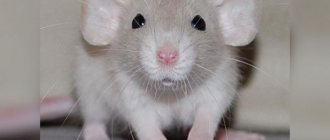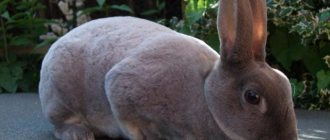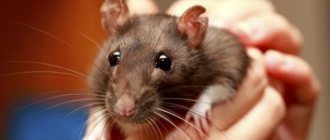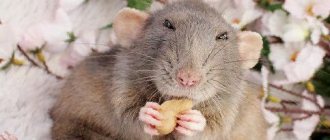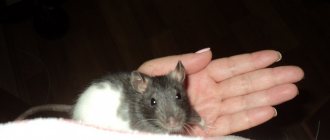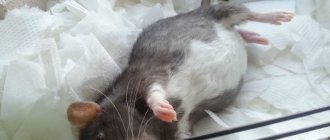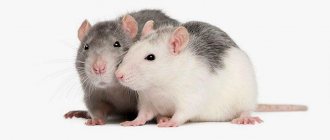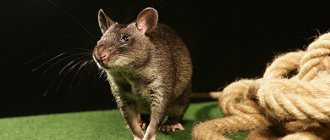- home
- Rat
- Varieties
07/07/2019 Rex is considered one of the most charming breeds of rats. Animals of this species have an attractive appearance, have high intelligence, are friendly and easy to make contact with. All this led to their popularity as pets.
Description of appearance
What makes the animals unique is mainly their curly fur. Otherwise, they are similar to individuals of other breeds.
It is not difficult to recognize Rex by his appearance. In a healthy purebred animal:
- the coat is thick and curly, without bald patches or “rosettes”;
- the curls on the fur are elastic;
- the muzzle is wide and blunt;
- the ears are large, widely set;
- the tail is fluffy.
If you have problems
The Rex breed is an excellent choice for those who dream of having a beautiful and funny animal. Such pets charm with their playful disposition and become attached to their owner. You'll never get bored with them! But what if the rodent suddenly gets sick, becomes sad or loses its appetite?
In this case, the best solution would be to go to the veterinary clinic. Experienced specialists are well versed in the characteristics of all breeds and will give you many valuable recommendations.
Characteristics and Features
On average, adult representatives of the breed have the following parameters:
- height – 8-20 cm for females, 17-25 cm for males;
- weight – 250-500 g for females, 400-850 g for males;
- tail length – up to 12 cm.
The distinctive features of the unique coat of rats include:
- curliness (a la sheepskin);
- lack of undercoat in adults (it falls out of the animal at a young age);
- hardness (including due to the lack of an undercoat layer);
- localization of curliness on the sides and back;
- wrinkling of individual hairs (this is especially pronounced in young animals before the formation of curls on their fur);
- matte color (against the background of the fur of rats of other decorative breeds, the fur of Rex looks dull);
- variety of colors (rex fur comes in a variety of colors, there are even spotted ones, but due to the heterogeneous structure of the fur, the spots are almost indistinguishable).
Rats of this breed have curled not only fur, but even whiskers, which are also noticeably shorter than those of other varieties.
Rex rat
8K 2 7 min.
First of all, Happy New Year. Secondly, with a new cycle: for some fabulous reasons, the eastern twelve-year animal calendar begins with a rat. Which will be the symbol of the coming year, for which I congratulate you
Previous photo
Photo: © Mark Taylor / Nature Picture Library / Lori Photobank
Photo: Alamy/VOSTOCK Photo
Photo: Alamy/TASS
Next photo
1 / 3
Photo: © Mark Taylor / Nature Picture Library / Lori Photobank
Photo: Alamy/VOSTOCK Photo
Photo: Alamy/TASS
As understanding people assure us, what awaits us is not just any rat, but a specifically white and iron rat. Well, about the iron one, please go to Z. Tsereteli. As for the white one, this is possible, although wouldn’t she be too laboratory, especially if she was born a red-eyed albino? By the way, red eyes and especially a bare tail are the main complaints made against rats by those who are afraid of these adorable rodents and squeal desperately in their presence.
A bare tail, you see, is disgusting to them! However, the tail may not be naked - if you get not just a rat, but a rat of the Rex breed, which means “king” in Latin. For some reason, many curly-haired animals, cats, guinea pigs, hamsters, and our very popular rats, are called rexes. True, the Tyrannosaurus rex did not seem to be curly. But he was majestic.
So, the royal tail. Yes, he is not bald, but you shouldn’t count on meeting a rat equipped with a luxurious squirrel poop: the Rex’s tail is not hairless, just like for a rat, it’s hard to call it so luxuriously fluffy. And yet there is some fur on the tail, so leave your complaints.
In general, the main difference between Rex and other rats is their fur, which is quite hard, slightly longer than usual and cutely curly, especially on the back and sides. Moreover, Rexes also have curly mustaches, and all this curl gives the rat a charmingly disheveled appearance, as if it had just jumped out of bed and, having discovered its fatal delay, rushed to take the child to kindergarten without having time to make any mess. Well, teenage rexes, whose curls have not yet formed, are particularly disheveled, and even bald spots from the falling out of the youthful undercoat, but with age these children straighten out and become noticeably prettier, although the cute carelessness of their hairstyle remains with them forever. And the rex, who is also a dumbo, that is, a curly-haired owner of prominent, downright gigantic ears, becomes completely irresistible, so that the most brutal lumberjack, at the sight of such beauty, will definitely begin to speak in a special stupid squeaky-lisping voice, usually reserved exclusively for cute children and chubby puppies.
Where did curly-haired rats come from in the world? They were bred artificially - it happened that in the litter of the most traditional decorative rats, babies were born decorated with a curl or two. They were selected, married with others of the same kind, and that’s how it all turned out, thanks to the diligent breeders, who, to our delight, secured the curly gene in these distant descendants of ordinary inhabitants of the trash heap.
The wild rat pasyuk is a cunning, intelligent, arrogant, aggressive creature, not at all kind and often not very healthy, so it’s probably not worth catching a pet in a dark gateway. Well, decorative rats, who have lived with people for generations in love, satiety, affection and care, are cute and so well brought up that they would be shocked if they met their wild relatives. However, they still have something in common - decorative rats have retained their intelligence and a bit of cunning, while becoming kind, trusting, affectionate, cheerful and playful. Moreover, there is an opinion that it is rex cats that are distinguished by increased playfulness. Apparently, along with the curls, they also got a particularly happy, easy-going character.
Rexes also have a muzzle that is a little wider and a little less sharp than is typical for other rat variants. Otherwise, our curly-haired beauties are not much different from other decorative rats. Which is not surprising, since they are all relatives, Rattus norvegicus domestica. That is, Norwegian domestic rats, descendants of simply gray Norwegian rats Rattus norvegicus .
And don’t be confused by the fact that they are Norwegian: they are worldwide, and they were mistakenly considered Norwegian by 18th-century naturalists, who believed that rats came to Europe exclusively on Norwegian ships. In fact, rats are great cosmopolitans, and on whose ships they go where, they have always been deeply indifferent. And their real historical homeland is East Asia, where they began their quest for world domination thousands of years ago, and now they live everywhere, except perhaps Antarctica. And even then, if we thoroughly scour the polar explorers’ pantries, won’t we find a warm little bee there too?
By the way, you can make friends with such a hypothetical Antarctic sucker. He is lonely and sad, and by luring him with all sorts of goodies, the kind polar explorer will eventually gain his trust and even love. But you don’t even need to seek the love of a decorative rat; she already likes you, in advance.
Rex in numbers is 10–25 cm in length, 10–12 cm of non-naked tail and 300–600 grams of weight (girls are smaller, boys, respectively, larger), and all this is available to us for mere pennies, that is, for about 500 –1500 rubles per piece. As for the colors, they can be anything - however, curls look better on a plain coat, because because of the curls, the spots seem not so bright. As for abilities and needs, in this sense the Rex does not demonstrate anything supernatural; it needs exactly the same as any domestic rat.
For example, good company - rexes are considered one of the most socialized rats. This means that you can have several rexes at once, but they, of course, will not get confused and will immediately begin to reproduce at an average speed of a dozen or two babies per month for each lady. And in a year you'll be walking around knee-deep in curly rats, which is cute but creepy. But it’s not boring—neither you nor your rexes.
Of course, in order to avoid rapid growth of the population, you can have same-sex rats, but conflicts are possible here. Unless you take several very young rexies from the same litter - these, even formidable males, will most likely get along very well. But they will begin to die more or less at the same time, what a tragedy: the life of a rat is tragically short, two or three years.
Well, the owner of a lonely rat must entertain it on his own. That is, equip her spacious cage with all sorts of swings, special pipes for her to climb, ladders, houses, hammocks, sticks to chew on, and other things. However, we can’t stop there either: swings are not enough for the sociable Rex, give him human warmth. In the sense of warmth, that is, attention and care: these cute rats will willingly sit on your shoulder, sleep on your lap, walk around your body, improve your hairstyle, and so on. Rexes can also be taken outside - when it’s warm, they are afraid of drafts. Of course, they should not be allowed to run freely on the grass; their walk means sitting proudly on their master’s shoulder or shyly peeking out from behind their bosom, and just in case, it would be better to put a harness on the animal, to be on the safe side. You can put a rat on a leash on the ground, let it walk around and warm up, but only in a clean and quiet place. Just don’t allow admiring passers-by to approach your rat: when frightened, the baby can wriggle out of the harness and run away into the blue distances, from which few return.
It must be said that a frightened rat, even one as nice as a rex, may well bite. Therefore, you should not give it to a small child: a human child will begin to kiss his pet too savorily or hug him too tightly to his chest, the rat will be frightened by such passions, will begin to resist, bite and scratch, the child will scream, the rat will be even more frightened and will strengthen its protective measures... Nightmare .
By the way: she can also bite her housemates, especially small ones - mice, hamsters, birds, turtles and so on. And some rats with increased dexterity manage to catch aquarium fish and also bite them. How do they bite? They eat it and that’s it. What did you want? These innocent eyes and curly mustache belong to a clever and dangerous predator!
However, if you are not a fish, then why should you be afraid? Rex will be crushingly gentle with you! He loves to be petted and scratched, and if you decide to tickle your pet, he may begin to giggle flirtatiously, although mostly with ultrasound, and yet: many rats, not just rexes, react to tickling in exactly the same way as and we are with you.
And in general, rexes are touchingly happy when people pay attention to them. As soon as you walk past the cage, he is already jubilant, jumping, spinning, galloping, waiting to be picked up, stroked, let out for a walk... But taking a walk is only in your society: even the best of rats are still rodents, and they will definitely chew if not all, but a lot. And our kings are also very curious, and out of considerations “is there anything interesting there?” they can climb into places they can’t get out of on their own.
Fortunately, most rexes know their name very well and come when called. And for any. Let's say you meant to call a cat or a dog (with which rats usually get along wonderfully). But who is it that is fussily getting under their feet? Who is the first to arrive at the master's call, with his funny curly mustache spread out in excitement? Of course, a smart rex, suspecting that the competitors were invited specifically so that they could be fed something stunning secretly from the poor rat.
Because rats love to eat. In fact, they are omnivores, but they must be fed carefully, refraining from smoked-fatty-sweet-salty-fried-pickled harmful foods. Special food for rats, pieces of fruit and vegetables, a drop of low-fat cottage cheese, a little yogurt, a cracker, a couple of nuts, a spoonful of porridge, a crumb of boiled chicken - this is what a rat should be happy with. And she, in principle, is satisfied, but not completely, she would always like something like that. And a good appetite, combined with great intelligence and dexterity, allows the Rex to get to all your stashes of junk food, unless you hid them in a forged steel box locked with a barn lock.
And how they beg! Sitting in a cage, they watch the human meal with the most pathetic look, holding onto the bars with tiny trembling paws and brilliantly depicting the terminal stage of starvation. And being in the wild during the master's feast, the rex does not hesitate to climb onto the table, or even directly into the plate... All this is very cute, you just want to give in and treat it. But you can’t: junk food will further shorten your rat’s already fleeting life.
Detractors claim that rats stink, but this, of course, is not true: if a certain aroma appears in the house, it means that the honest Rex got careless owners who neglected to regularly clean the cage. But the rat itself is very neat - it takes care of its fur, goes to the toilet modestly, in a corner. By the way, you can put a tray with filler in this corner, and after some time the Rex will figure out what’s what: rats are generally very smart and are usually easy to train. They can be taught to stand on their hind legs, lie down, give paws, wash themselves, dance, roll a ball or a spool of thread, and much more. If the rats had lived longer, they might have learned to darn socks.
Subspecies
The breed includes three subspecies. The main one is the breed standard described above. The other two are intrabreed subspecies:
- Dumbo Rex (the variety is named after the famous baby elephant from the Disney cartoon, so the peculiarity of the Dumbo Rex rat is immediately clear from its name - these are large round ears, the fur of the animal does not differ from the breed standard);
- Double Rex (a semi-hairless variety - the rat looks as if it had been shorn, the fur of the animal is very short, sticking out in different directions due to curliness, otherwise the appearance of the animal does not differ from the breed standard).
Use in research
Dissection of a laboratory rat
The rat found early use in laboratory research in five areas: W. S. Small proposed that speed of learning could be measured by using rats in a maze; sentence used by John B. Watson for his Ph.D. defended his dissertation in 1903. The first rat colony in America used for nutrition research was founded in January 1908 by Elmer McCollum, and the nutritional requirements of rats were subsequently used by Thomas Burr Osborne and Lafayette Mendel to determine the details of protein nutrition. Reproductive function in rats was studied at the Institute of Experimental Biology at the University of California, Berkeley by Herbert McLean Evans and Joseph A. Long. The genetics of rats was studied by William Ernest Castle at the Bussey Institute at Harvard University until it closed in 1994. Rats have long been used in cancer research; for example, at the Crocker Cancer Research Institute.
A rat passes the morris navigation test
The species' historical importance to scientific research is reflected in the amount of literature about it: approximately 50% more than that for laboratory mice. Laboratory rats are often subjected to necropsy or microdialysis to study internal effects on organs and the brain, such as for cancer or pharmacological research. Uneuthanized laboratory rats may be killed or, in some cases, become pets.
A rat is deprived of REM sleep using the flowerpot technique
Domestic rats differ from wild rats in many ways: they are calmer and bite much less frequently, they can tolerate larger crowds of people, they reproduce earlier and produce more offspring, and their brains, livers, kidneys, adrenal glands and hearts are smaller.
Scientists have bred many strains or “strains” of rats specifically for experimentation. Most are derived from the albino Wistar rat, which is still widely used today. Other common strains are the Sprague Dawley, Fischer 344, Holtzman albino, Long-Evans and Lister black rats. Inbred strains are also available, but are not commonly used as inbred mice.
Most of the Rattus
has been sequenced. In October 2003, researchers were able to clone two laboratory rats using nuclear transfer. This was the first in a series of developments that began to make rats suitable for genetic research, although they still lag behind mice, which are more amenable to embryonic stem cell techniques that are commonly used for genetic manipulation. Many researchers who want to trace observations of behavior and physiology back to underlying genes find aspects of them in rats to be more relevant to humans and easier to observe than in mice, giving rise to the development of genetic research methods applicable to rats.
A rat traverses difficult terrain under the influence of electrodes fed into its brain.
A 1972 study compared tumors in Sprague Dawley rats from six different commercial suppliers and found highly significant differences in the incidence of endocrine and mammary tumors. There were even significant differences in the incidence of adrenal medulla tumors among rats from the same source bred in different laboratories. All but one testicular tumor occurred in rats from a single supplier. The researchers found that the incidence of tumors in Sprague-Dawley rats from different commercial sources varied as much as in other strains of rats.
The study authors "emphasized the need for extreme caution when evaluating carcinogenicity studies conducted in different laboratories and/or in rats from different sources."
During food rationing due to World War II, British biologists ate lab rats with cream.
Nutrition
The rat diet should be based on ready-made food. Mandatory feed additives include cereals and vitamins. You can feed your pet with the following:
- half-boiled porridge;
- fruits (especially apples and plums);
- greens;
- boiled lean chicken;
- boiled eggs;
- fruits;
- seeds;
- sour cream;
- kefir
Unsweetened crackers can be given as a treat.
What affects life expectancy
Dumbo rats are unpretentious, so they have managed to adapt to living conditions in many countries. At minimal cost, owners get a cute pet with an easy-going character and extraordinary intelligence.
Conditions of detention
Rats feel great in small cages (60x40x60cm) with metal bars. The cage must have:
- deep plastic tray;
- solid bottom;
- wide doors;
- shelves;
- stairs;
- ropes.
The Dumbo family is very friendly, so several rodents can easily fit into the cage. Together they feel completely comfortable: they do the cleaning and brush out the fur.
A small house inside the cage will add comfort to the Dumbo rats. Babies love to retire and take a nap in silence. Adult pets will appreciate a warm hammock; they will be happy to spend their leisure time there.
Wood or corn filler will help eliminate the specific odor from the rat family. Sometimes owners try to lay napkins or toilet paper on the bottom, but this option is not suitable for rats. Regular cleaning will also help keep the cage clean. Twice a week it is necessary to remove leftover food and used filler, change the water in the drinking bowl, and carry out disinfection.
Dumbos at home should live in a warm room where there are no drafts and moisture. Rats are very sensitive to sharp sounds, blinding light, and overheating. They get tired of people's annoying attention.
Diet
Dumbo rats, unlike rodents that live in the wild, are very sensitive to the consumption of low-quality food. Poor nutrition can easily provoke gastrointestinal disorders and allergies, so owners will have to create a diet according to certain rules.
The rat's menu must include:
It is strictly forbidden to give Dumbo rats fatty and fried food from the master's table, alcohol, sausage, sprouted potatoes, green bananas. The quality of the food should not be in doubt, otherwise the pet will become ill.
Young rats are fed 3–4 times a day. Adult pets need only two meals a day.
It is important to remove uneaten food debris so that the rodent does not eat spoiled pieces.
Hygiene
Dumbo rats are real clean people. They clean their fur and wash themselves, so you don’t have to bathe them often. Water procedures will be required if the pet gets very dirty. Rats, unlike other pets, love to swim. They can splash around in warm water for a long time.
Bathing is carried out with special shampoos in a warm room without drafts. It is necessary to ensure that water does not get into your pet’s ears, which can lead to hearing loss. After bathing, the rat is wrapped in a warm towel and dried well. If the room is cold, it is better to dry the fur with a warm stream from a hairdryer.
One of the dangers of swimming is hypothermia. A frozen rat can easily catch a cold. Therefore, in the cold season, the doors and windows in the room are tightly closed, and a heater is placed near the cage.
Entertainment
Caring for and maintaining Dumbo rats means not only food and a cozy home, but also a kind of gym. In the absence of the owner, the animals entertain themselves by climbing ropes and rope ladders, and passing through tunnels. Some craftsmen make toys for pets on their own.
Arrangement of the cage
A rat in a cage needs to have fun. It is necessary to regularly refresh the food and clean the cage. These are clean animals. The cage must be disinfected twice a month. Serve the bulk of the food in the evening. But the rex must always have clean drinking water.
And then the cheerful curly-haired Rex rat will live up to the owner’s hopes and will be interesting to play with. You can choose a pet of any color. Rexes have a friendly character and a pretty appearance.
Did you like the article? Share with friends: [supsystic-social-sharing id=”1"]
- Related Posts
- Types and breeds of decorative rats
- How to Choose the Ideal Rat Cage
- Rat house
« Previous entry
By coat color
Decorative rats are also conventionally divided into several groups according to the type and color of their coat.
Homogeneous (Self)
Rodents of this species have absolutely the same coloring throughout their entire body. Rats are black, white, blue (color with a silver tint. Russian blue and smoky blue are also found. They are very similar in color, the former have a dark color and a light belly, and the latter have a more pronounced blue tint.
Rats in gray-brown tones with a silver-bluish tint with cherry eyes are called mink. There is also an American mink species, these animals have a darker eye shade.
Light gray color with a cool blue tint. The eyes are black or dark red. This is a platinum shade.
Blue, platinum rat
The beige color of the rats resembles coffee with milk. And completely white animals with red eyes are usually called albinos.
Very beautiful coloring of rats - champagne. This species of animal has a light, slightly pinkish color. The eyes are pink.
Russian silver is an interesting light gray color with a blue tint. This variety is characterized by fuzzy ripples of color.
The main color of the “dav” species is pale gray with a pinkish tint. It has a characteristic light ripple. Rat "Lilak" - light ash color, slightly mixed with chestnut color. Eyes black or dark cherry.
Officially unrecognized colors of domestic rats:
- Chocolate;
- Russian beige;
- Caramel.
Ticked colors
They are distinguished by uneven coloring of the hairs, that is, there are places on them that may have pigments of different colors.
Agouti
This coloring is characterized by a beautiful chestnut color. Some hairs are black. Short and medium hairs have bands. They must be free of orange and yellow, and it is better if they are of the lightest shades.
The base color consists of a dark gray or light brown tint. The ends of the hairs are black and the belly is silver-gray.
Rat – Agouti
There is also a blue agouti - the belt of hairs can be red and brown, and the belly is light gray-blue with inclusions of silver hairs.
Incredibly beautiful shade of platinum agouti. This bright color is combined using two colors: light gray and beige with a cool blue tint. Each hair has a light blue base with a beige edge. The belly is light silver.
Amber (Amber)
Rich color of yellow and orange shades. Each hair has an ivory border. The guard hairs have a silvery tint. The undercoat is cream and the belly is light. The eyes are pink.
Amber color
Cinnamon
Rodents are colored in red-brown tones with inclusions of darker guard hairs, which have bright golden and red edgings. The belly is gray with silver, and the eyes are black or cherry.
Faun
These rodents have a beautiful coffee color with a golden tint with the inclusion of silvery guard hairs. There is a not very expressive golden-red pattern. The belly is cream and silver, and the eyes are the color of dark ruby.
Breed – Fawn
Topaz
This color is similar to the Fawn color, however, it is not as rich and has a lighter undercoat.
Pearl
This species has a light, silvery tint. Eyes black or dark ruby. There are also 2 subspecies: Pearl cinnamon and Pearl blue. The first color consists of three colors: beige, golden and light gray.
Overall, it is golden with a silvery tint. Eyes black or dark ruby. The second color is light with beige and gray shades. Each hair is silver-gray in color. The belly is grayish-beige, and the eyes are black or dark cherry.
Pearl rat
Silver colors
The uniqueness of this color lies in the variation of silver and colored hairs in the same number. It should be obvious and designed to create the impression of brilliance and sparkle. If there are inclusions of white hairs, then the color is no longer recognized as silver.
- Silver-black. The color of such rodents is deep black with uniform inclusions of silver hairs. The eyes are black.
- Silver blue. The color is gray with a blue tint. Individual hairs are silvery-white. The undercoat is light gray with a blue tint.
- Silver mink. Deep brown color with a gray tint. Has the same amount of silver and brown hairs.
Combined colors
This category includes the colors of rats, consisting of a combination of several colors.
Siamese
The animal has a beige color that darkens in the back of the body, moving from the lower back to the tail, and also from the belly to the upper back. The tail is dark at the base along its entire length. The rodent has brown spots on its ears, legs up to the elbows and on its face.
Siamese rat
Additionally there are:
- Siamese with black eyes. The color is standard for this species, the eyes are dark.
- Siamese blue. It has a cream color with a silver tint that darkens on the back of the body.
- Siamese Russian Blue. The color is beige, gradually darkening in the back of the body. There are dark brownish spots.
Himalayan
Snow-white color, which is uniform throughout the body. There are dark brown spots. The eyes are red. The paws are slightly colored. The Black-eyed Himalayan is a white rodent with cream spots.
Burmese
Has an even brown color. Wheaten Burmese - the animal has a sandy color with spots of slightly darker tones. The hairs have a yellowish band and a light silver-gray belly.
Breed – Burmiz
Sable
Coffee coloring with dark spots on the paws.

